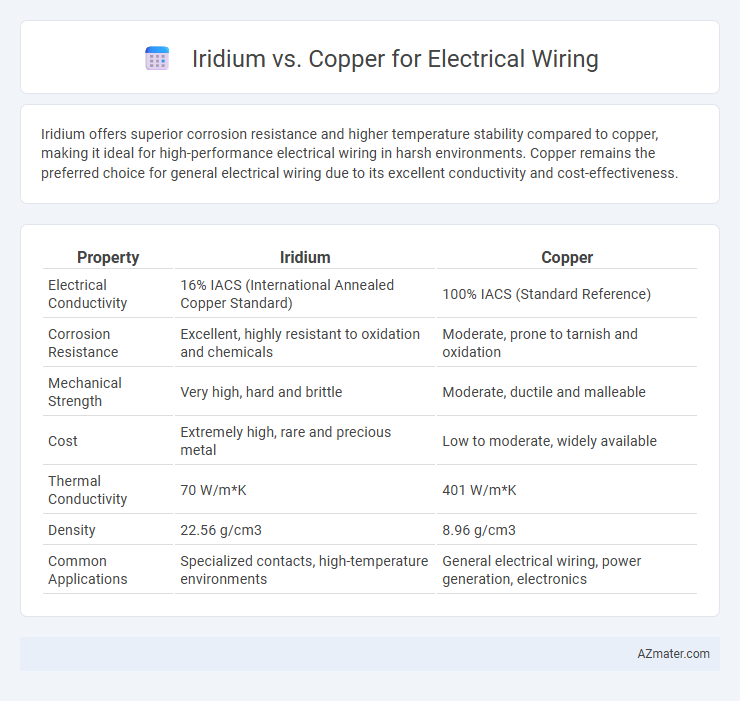Iridium offers superior corrosion resistance and higher temperature stability compared to copper, making it ideal for high-performance electrical wiring in harsh environments. Copper remains the preferred choice for general electrical wiring due to its excellent conductivity and cost-effectiveness.
Table of Comparison
| Property | Iridium | Copper |
|---|---|---|
| Electrical Conductivity | 16% IACS (International Annealed Copper Standard) | 100% IACS (Standard Reference) |
| Corrosion Resistance | Excellent, highly resistant to oxidation and chemicals | Moderate, prone to tarnish and oxidation |
| Mechanical Strength | Very high, hard and brittle | Moderate, ductile and malleable |
| Cost | Extremely high, rare and precious metal | Low to moderate, widely available |
| Thermal Conductivity | 70 W/m*K | 401 W/m*K |
| Density | 22.56 g/cm3 | 8.96 g/cm3 |
| Common Applications | Specialized contacts, high-temperature environments | General electrical wiring, power generation, electronics |
Introduction to Iridium and Copper in Electrical Wiring
Iridium, a rare and corrosion-resistant metal, is valued in specialized electrical wiring applications for its exceptional conductivity and durability under extreme conditions. Copper, widely used in electrical wiring, offers excellent electrical conductivity, thermal efficiency, and affordability, making it the standard choice in residential and commercial installations. While copper dominates the market due to its balance of performance and cost, iridium's superior resistance to oxidation and mechanical strength make it suitable for high-reliability environments such as aerospace and electronics.
Physical Properties Comparison
Iridium exhibits exceptional corrosion resistance and high melting point around 2,446degC, making it highly durable in extreme environments compared to copper, which melts at 1,085degC and is more prone to oxidation. Copper offers superior electrical conductivity (approximately 5.96 x 10^7 S/m) compared to iridium's lower conductivity, making copper more efficient for standard electrical wiring applications. However, iridium's hardness and mechanical strength ensure greater resistance to wear and deformation under mechanical stress, whereas copper's ductility allows easier fabrication and bending for wiring installations.
Electrical Conductivity Differences
Iridium has significantly lower electrical conductivity compared to copper, with copper's conductivity being approximately 5.96 x 10^7 S/m, making it one of the best conductors for electrical wiring. Iridium's conductivity is much less efficient, roughly 1.5 x 10^7 S/m, due to its dense atomic structure and higher resistivity. Copper's superior conductivity ensures minimal energy loss and heat generation, making it the preferred choice for most electrical wiring applications over iridium.
Corrosion Resistance and Longevity
Iridium exhibits superior corrosion resistance compared to copper, making it highly durable in harsh or reactive environments where copper may oxidize or degrade over time. The longevity of iridium wiring significantly outperforms copper due to its resistance to tarnishing and extreme temperatures, ensuring stable electrical conductivity for extended periods. Copper remains a cost-effective choice but requires protective coatings or maintenance to prevent corrosion, whereas iridium's natural resilience reduces long-term replacement and repair needs.
Cost Analysis of Iridium vs Copper
Iridium wiring costs significantly more than copper due to iridium's rarity and complex extraction process, resulting in a price per kilogram that can exceed copper by thousands of times. Copper remains the industry standard for electrical wiring because of its excellent conductivity and affordability, with prices typically ranging between $8 and $10 per kilogram, while iridium can cost upwards of $4,000 per kilogram. The high cost of iridium severely limits its practical use for electrical wiring despite its superior corrosion resistance and durability.
Availability and Sourcing Challenges
Copper remains the dominant choice for electrical wiring due to its widespread availability and well-established mining and recycling infrastructure, ensuring a stable supply chain. Iridium, being a rare platinum-group metal primarily sourced from limited mines in South Africa and Russia, faces significant sourcing challenges and high costs that hinder its large-scale use in electrical applications. The scarcity and geopolitical concentration of iridium deposits contribute to supply volatility, making copper the more practical and economically viable option for most wiring needs.
Typical Applications in Electrical Systems
Iridium is rarely used for electrical wiring due to its high cost and limited availability, but it excels in specialized applications requiring extreme corrosion resistance and high-temperature stability, such as aerospace and high-performance electronic connectors. Copper remains the dominant material for electrical wiring in residential, commercial, and industrial systems owing to its excellent electrical conductivity, flexibility, and cost-effectiveness. Typical applications of copper wiring include power distribution, grounding systems, and telecommunications infrastructure, where reliability and ease of installation are critical.
Safety and Handling Considerations
Iridium offers exceptional corrosion resistance and high melting point, making it highly durable but significantly more expensive and difficult to handle compared to copper. Copper remains the industry standard for electrical wiring due to its excellent conductivity, ease of installation, and effective thermal management, which enhances safety by reducing fire risks. Safety considerations favor copper as it is more flexible, less brittle, and easier to inspect for faults, whereas iridium requires specialized tools and expertise for safe handling and installation.
Environmental Impact and Sustainability
Iridium, a rare and highly durable metal, offers superior corrosion resistance compared to copper but is significantly less abundant, leading to higher environmental costs due to intensive mining and refining processes. Copper remains the gold standard for electrical wiring because of its excellent conductivity, recyclability, and lower ecological footprint associated with its widespread availability and established recycling infrastructure. Sustainable electrical wiring solutions prioritize copper's balance of performance and environmental impact, while iridium's scarcity and energy-intensive production limit its viability for large-scale sustainable applications.
Future Trends in Electrical Wiring Materials
Iridium's superior corrosion resistance and electrical conductivity position it as a promising candidate for future high-performance electrical wiring applications, particularly in harsh environments. Copper remains the industry standard due to its excellent conductivity, affordability, and ease of installation, but emerging applications in aerospace and nanotechnology increasingly explore iridium-based alloys for enhanced durability. Advances in materials science continue to drive the development of hybrid wiring systems that leverage iridium's properties alongside copper to optimize longevity and efficiency in next-generation electrical infrastructures.

Infographic: Iridium vs Copper for Electrical Wiring
 azmater.com
azmater.com